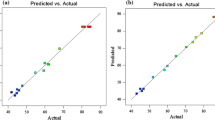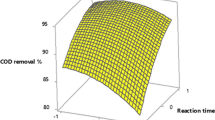Abstract
In this paper, dairy wastewater treatment was investigated by Fenton and electro-Fenton (EF) processes in respect of removal efficiencies of chemical oxygen demand (COD), orthophosphate, suspended solid (SS), and color. The response surface methodology (RSM) approach using Box–Behnken design was carried out to develop mathematical model and to optimize process parameters. Experimental data were analyzed by the analysis of variance (ANOVA) to identify the interaction mechanism between the process variables and the dependent variables. According to ANOVA results of Fenton process, COD removal increased with an increase in H2O2/COD ratio and reaction time but decreased with increased H2O2/Fe2+ ratio and initial pH. Opposing to that, in the EF process, COD removal increased with an increase in H2O2/Fe2+ ratio and reaction time but decreased with an increase in H2O2/COD ratio and initial pH. The COD removal efficiencies were 65.5 and 72% under the optimum conditions for Fenton (H2O2/COD ratio 1.9, H2O2/Fe2+ ratio 5, pH 4 and reaction time 10 min) and electro-Fenton (H2O2/COD ratio 2, current density 32 mA/cm2, pH 2.4 and reaction time 45 min) processes, respectively. No significant removal differences for orthophosphate, SS and color were determined between the two processes because the removal efficiencies were over the 88% for each process configuration where P value was greater than 5.6 * 10−5 with 99% confidence level and greater than 1.7 * 10−3 with 95% confidence level for all responses for Fenton and EF processes, respectively).









Similar content being viewed by others
References
Andrade LH, Mendes FDS, Espindola JC, Amaral MCS (2014) Nanofiltration as tertiary treatment for the reuse of dairy wastewater treated by membrane bioreactor. Sep Purif Technol 126:21–29
APHA (2005) Standard Methods for the Examination of Water and Wastewater, 21st edn. American Public Health Association/American Water Works Association/Water Environment Federation, Washington DC, USA
Arslan-Alaton I, Tureli G, Olmez-Hanci T (2009) Treatment of azo dye production wastewaters using Photo-Fenton-like advanced oxidation processes: optimization by response surface methodology. J Photochem Photobiol A: Chem 202:142–153
Ayhan Şengin İ, Özacar M (2006) Treatment of dairy wastewaters by electrocoagulation using mild steel electrodes. J Hazard Mater B137:1197–1205
Ayoub K, Van Hullebusch ED, Cassir M, Bermond A (2010) Application of advanced oxidation processes for TNT removal: a review. J Hazard Mater 178:10–28
Balannec B, Vourch M, Rabiller-Baudry M, Chaufer B (2005) Comparative study of different nanofiltration and reverse osmosis membranes for dairy effluent treatment by dead-end filtration. Sep Purif Technol 42(2):195–200
Banu JR, Anandan S, Kaliappan S, Yeom IT (2008) Treatment of dairy wastewater using anaerobic and solar photocatalytic methods. Solar Energy 82(9):812–819
Baskaran K, Palmowski LM, Watson BM (2000) Wastewater reuse and treatment options fort he dairy industry. Water Sci Technol 3:85–91
Bautista P, Mohedano AF, Casas JA, Zazo JA, Rodriguez JJ (2008) An overview of the application of Fenton oxidation to industrial wastewaters treatment. J Chem Technol Biotechnol 83:1323–1338
Bazrafshan E, Moein H, Mostafapour FK, Nakhaie S (2013) Application of electrocoagulation process for dairy wastewater treatment. J Chem. https://doi.org/10.1155/2013/640139
Chang PH, Huang YH, Hsueh CL, Lu MC, Huang GH (2004) Treatment of non-biodegradable wastewater by electro-Fenton method. Water Sci Technol 49(4):213–218
Chen Z, Luo J, Hang X, Wan Y (2018) Physicochemical characterization of tight nanofiltration membranes for dairy wastewater treatment. J Membr Sci 547:51–63
Cheng M, Zeng G, Huang D, Lai C, Xu P, Zhang C, Liu Y (2016) Hydroxyl radicals based advanced oxidation processes (AOPs) for remediation of soils contaminated with organic compounds: a review. Chem Eng J 284:582–598
Dabrowski W, Zylka R, Malinowski P (2017) Evaluation of energy consumption during aerobic sewage sludge treatment in dairy wastewater treatment plant. Environ Res 153:135–139
Davarnejad R, Nikseresht M (2016) Dairy wastewater treatment using an electrochemical method: experimental and statistical study. J Electroanal Chem 775:364–373
Deshpande DP, Patil PJ, Anekar SV (2012) Biomethanation of dairy waste. Res J Chem Sci 2(4):35–39
Erkan HS, Apaydın Ö (2015) Final treatment of young, middle-aged, and stabilized leachates by Fenton process: optimization by response surface methodology. Desalin Water Treat 54:342–357
Farizoglu B, Uzuner S (2011) The investigation of dairy industry wastewater treatment in a biological high performance membrane system. Biochem Eng J 57:46–54
Fenton HJH (1896) Oxidation of tartaric acid in presence of iron. J Chem Soc 65:899–910
Gengec E, Kobya M, Demirbas E, Akyol A, Oktor K (2012) Optimization of baker’s yeast wastewater using response surface methodology by electrocoagulation. Desalination 286:200–209
Gotvajn AZ, Zagorc-Koncan J, Cotman M (2011) Fenton’s oxidative treatment of municipal landfill leachate as an alternative to biological process. Desalination 275:269–275
Karadag D, Köroğlu OE, Ozkaya B, Cakmakci M (2015) A review on anaerobic biofilm reactors for the treatment of dairy industry wastewater. Process Biochem 50(2):262–271
Kim SC (2016) Application of response surface method as an experimental design to optimize coagulation-flocculation process for pre-treating paper wastewater. J Ind Eng Chem 38:93–102
Körbahti BK (2007) Response surface optimization of electrochemical treatment of textile dye wastewater. J Hazard Mater 145:277–286
Körbahti BK, Rauf MA (2008) Response surface methodology (RSM) analysis of photo induced decoloration oftoludine blue. Chem Eng J 136:25–30
Kushwaha JP, Srivastava VC, Mall ID (2010a) Treatment of dairy wastewater by inorganic coagulants: parametric and disposal studies. Water Res 44:5867–5874
Kushwaha JP, Srivastava VC, Mall ID (2010b) Organics removal from dairy wastewater by electrochemical treatment and residue disposal. Sep Purif Technol 76:198–205
Loloei M, Alidadi H, Nekonam G, Kor Y (2014) Study of the coagulation process in wastewater treatment of dairy industries. Int J Environ Health Eng 3(1):12
Luo J, Ding L, Wan Y, Paullier P, Jaffrin MY (2012) Fouling behavior of dairy wastewater treatment by nanofiltration under shear-enhanced extreme hydraulic conditions. Sep Purif Technol 88:79–86
Mohajeri S, Aziz HA, Isa MH, Zahed MA, Adlan MN (2010) Statistical optimization of process parameters for landfill leachate treatment using electro-Fenton technique. J Hazard Mater 176:749–758
Oturan MA, Peiroten J, Chartrin P, Acher AJ (2000) Complete destruction of p-nitrophenol in aqueous medium by electro-Fenton method. Environ Sci Technol 34:3474–3479
Perle M, Kimchie S, Shelef G (1995) Some biochemical aspects of anaerobic degradation of dairy wastewater. Water Res 29(6):1549–1554
Praneeth K, Moulik S, Vadthya P, Bhargava SK, Tardio J, Sridhar S (2014) Performance assessment and hydrodynamic analysis of a submerged membrane bioreactor for treating dairy industrial effluent. J Hazard Mater 274:300–313
Qiang Z, Chang JH, Huang CP (2003) Electrochemical regeneration of Fe2+ in Fenton oxidation processes. Water Res 37(6):1308–1319
Ramasamy EV, Gajalakshmi S, Sanjeevi R, Jithesh MN, Abbasi SA (2004) Feasibility studies on the treatment of dairy wastewaters with upflow anaerobic sludge blanket reactors. Bioresour Technol 93(2):209–212
Sengil A, Ozacar M (2006) Treatment of dairy wastewaters by electrocoagulation using mild steel electrodes. J Hazard Mater 137:1197–1205
Tchamango S, Nanseu-Njiki CP, Ngameni E, Hadjiev D, Darchen A (2010) Treatment of dairy effluents by electrocoagulation using aluminium electrodes. Sci Total Environ 408:947–952
Turan M (2004) Influence of filtration conditions on the performance of nanofiltration and reverse osmosis membranes in dairy wastewater treatment. Desalination 170(1):83–90
Vourch M, Balannec B, Chaufer B, Dorange G (2008) Treatment of dairy industry wastewater by reverse osmosis for water reuse. Desalination 219(1–3):190–202
Weast RC (1969) Handbook of chemistry and physics. Am J Med Sci 257:423
Wheatley A (1990) Anaerobic digestion: a waste treatment technology. Elsevier Applied Science, London and New York
Yavuz Y, Öcal E, Koparal AS, Öğütveren ÜB (2011) Treatment of dairy industry wastewater by EC and EF processes using hybrid Fe-Al plate electrodes. J Chem Technol Biotechnol 86:964–969
Zhang H, Zhang D, Zhou J (2006) Removal of COD from landfill leachate by electro-Fenton method. J Hazard Mater 135:106–111
Zhang H, Fei C, Zhang D, Tang F (2007) Degradation of 4-nitrophenol in aqueous medium by electro-Fenton method. J Hazard Mater 145:227–232
Acknowledgements
The authors are grateful Atesoglu Dairy Factory for their collaboration. The authors also would like to thank the anonymous reviewers for their valuable comments and suggestions to improve the quality of the manuscript.
Author information
Authors and Affiliations
Corresponding author
Additional information
Editorial responsibility: M. Abbaspour.
Rights and permissions
About this article
Cite this article
Akkaya, G.K., Erkan, H.S., Sekman, E. et al. Modeling and optimizing Fenton and electro-Fenton processes for dairy wastewater treatment using response surface methodology. Int. J. Environ. Sci. Technol. 16, 2343–2358 (2019). https://doi.org/10.1007/s13762-018-1846-0
Received:
Revised:
Accepted:
Published:
Issue Date:
DOI: https://doi.org/10.1007/s13762-018-1846-0




